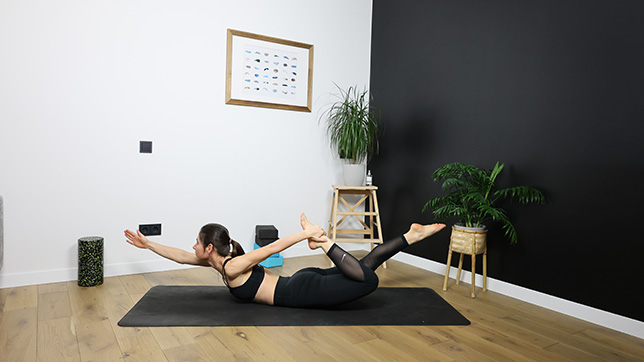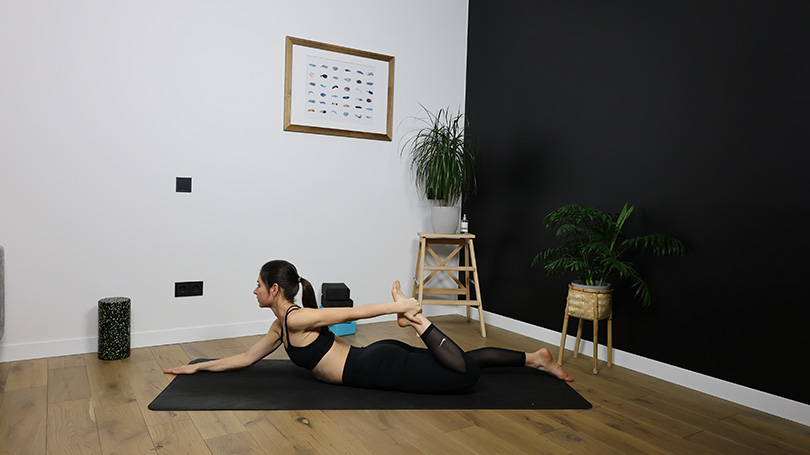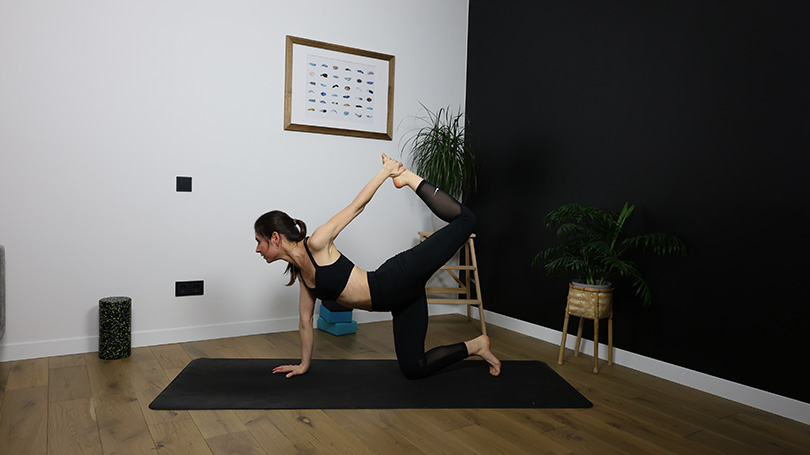Half Bow Pose - Ardha Dhanurasana

Contents
Half Bow Pose or Ardha Dhanurasana (ARE-dah don-your-AHS-anah) is a backbending asana that is a less intense variation of the common Hatha yoga pose, dhanurasana. From Sanskrit, ardha means “half,” dhanur means “bow” and asana means “pose.”
This asana stretches your spine and opens up your chest which gives space for your heart to grow and expand that does not come from regular breathing patterns. This in-turn boosts your energy levels and even improves your mood.
Half Bow Pose, or Ardha Dhanurasana, is a truly versatile pose, affecting many areas of the body as well as the mind. It greatly improves overall flexibility, putting the emphasis on particular muscle regions, demanding balance and focus at the same time.
Pose Detail
- Body Position: Backbend Yoga Poses, Supine Yoga Poses
- By Type: Balancing Yoga Poses, Chest Opening Yoga Poses, Flexibility Yoga Poses, Strengthening Yoga Poses
- Difficulty: Intermediate
Step-by-Step Instructions
Benefits and Contraindications
Improves balance
Opens the chest
Improves spine flexibility
Soothes the mind
Lengthens quadriceps and other leg muscles
Back, leg, neck, shoulder injury
Pregnancy
Recent abdominal surgery
Photo poses in different angles

Modifications and Props for Beginners
- Use a Strap: If you have tight shoulders or arms, it may be difficult to reach your foot with your hand in Half Bow Pose. To help with this, you can use a yoga strap. Loop the strap around the arch of your foot and hold onto the ends of the strap with your hands. As you lift your foot, gently pull on the strap to help you deepen the stretch.
- Use a Block: If you have trouble balancing in Half Bow Pose or feel like your chest is collapsing, you can place a yoga block under your chest. This will help to lift your chest and give you more stability in the pose.
Useful Tips
- Take it Slow. Half Bow Pose is a deep backbend, so it’s important to approach it slowly and mindfully. Start by practicing easier backbends, such as Cobra or Sphinx Pose, to warm up your spine and build strength.
- Keep Your Hips Even. As you lift your foot in Half Bow Pose, be mindful of your hips. Try to keep them even and parallel to the ground. This will help you maintain your balance and prevent any strain on your lower back.
- If you feel any pain or discomfort in your back or shoulders, come out of the pose and take a break. Don’t force the stretch beyond what feels comfortable for you.
- As you hold Half Bow Pose, focus on your breath. Take slow, deep breaths in and out through your nose. This will help to calm your mind and release any tension in your body.
- Remember, Half Bow Pose is a challenging pose, so it’s important to listen to your body and practice with care. With practice and patience, you can gradually work your way towards a deeper expression of the pose.
Variation
If it is still difficult for you to raise one arm and leg and do Ardha Dhanurasana, then you can not raise the arm and leg and remain in this position.

Kneeling Bow Pose
Extend one arm forward and the opposite leg to the back, ensuring the neck aligns with the spine. Bend the upper knee, reaching the extended hand backward to grasp the foot or toes. Elevate the knee and chest, forming an arch resembling a bow.

Frequently Asked Questions
Half Bow Pose can be challenging for beginners, especially if you have tight shoulders or a weak lower back. It’s important to approach the pose slowly and mindfully, and to use props if needed. It’s also a good idea to practice easier backbends, such as Cobra or Sphinx Pose, before attempting Half Bow Pose.
If you feel any pain or discomfort in your back while practicing Half Bow Pose, come out of the pose and take a break. It’s important to listen to your body and not push beyond what feels comfortable for you. You can try using props, such as a block or strap, to help you deepen the stretch without straining your back.
You can start by holding Half Bow Pose for 3-5 breaths, gradually working your way up to 10-15 breaths as you build strength and flexibility. It’s important to take breaks as needed and not overdo it.
If you have a back injury or condition, it’s important to consult with a healthcare professional before attempting Half Bow Pose. Depending on the severity of your injury, you may need to avoid certain backbends or modify the pose with props.
Variations
- Supported Half Bow Pose
- One-Legged Half Bow Pose
- Bow Pose
- Reclined Half Bow Pose